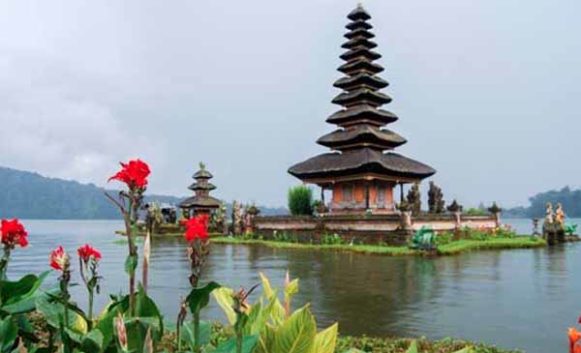Bali, Indonesia: Everything You Need to Know in 2023
When deciding to live in Bali, the most asked question is, “Where’s the best location for me?”
The island of Bali is around 95 miles wide and spans 70 miles north to south, so while most of the action is in the south, whatever location you decide on will not be remote as such. The expat hotspots are diverse and depend on your preference. Choose the vibe of Legian or the relaxed chill of Sanur or, for the country feel, head to the mountains of Ubud.

Being just eight degrees south of the equator, the temperature is pleasant all year round, wherever you choose. Add the fact that Bali is an affordable place to live and it’s not surprising that many expats have chosen to retire here.
Accommodation varies and can be found easily, from as little as $350 per month. Again, this is subject to what you’re looking for. Check out social media pages for rentals available and walk the streets—many signs are placed to advertise villas available. Be sure to chat with the locals, too. There’s always a friend of a friend who has a villa available.
There’s the bustling beach towns in the south or the calmer beaches of the north, with the lush, green rice fields and mountains nestled in between. Travel around the island and you’ll find places not mentioned in the travel brochures, filled with the culture and traditions that Bali is known for.
Here’s a quick reference for some of the best beach and mountain towns in Bali.
Legian & Seminyak

Legian spans just five blocks and neighbours the more up-market Seminyak. Both towns are only a 30-minute drive from the international airport. With Western-facing beaches, stunning Indian Ocean sunsets can be captured along the many stretches of shoreline. Wide streets, small alleyways, and many beachfront properties give you a more eclectic city vibe than some of the other towns in Bali.
Legian is known for its market shopping and casual beach bars, while Seminyak is popular for its high-end boutiques, international restaurants with some world-renowned chefs, and a mix of trendy bars and nightclubs.
Jalan Raya Legian turns into Jalan Raya Seminyak, and as you cross the areas, you’ll see a distinctive change in the types of stores and cafés. Jalan Arjuna (double six) is the main street of Legian, leading you to the white sandy beach, while Jalan Laksmana snakes through Seminyak and is now known as Eat Street, due to the many eateries on this stretch.
Seminyak Beach and Petitenget Beach are a continuous expanse of grey sand, stretching in both directions as far as the eye can see. To the south, it becomes Legian Beach and then Kuta Beach, but is noticeably quieter than both. The sunsets here are famous, and opportunities abound to mix with the jet set, who frequent the high-end beachfront establishments such as Ku De Ta and Potato Head Beach Club.Many small, apartment-style residences are available in Legian, while Seminyak offers roomier villas for long-term rentals.
Kuta & Tuban
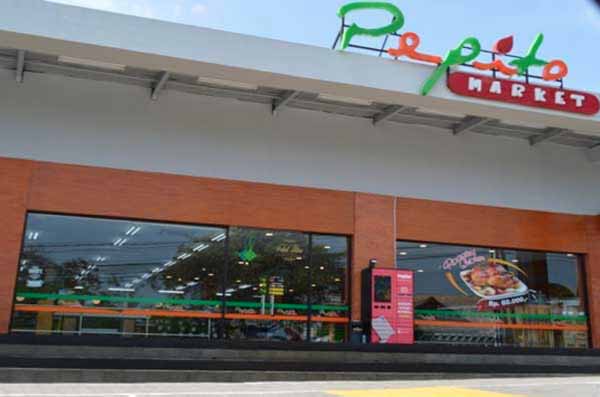
One of Bali’s first tourist developments—and it’s held the reputation as being “party central”—Kuta has an abundance of bars, cafés, warungs (small local eateries), and restaurants. Its beaches span three miles and are arguably the best in Bali. With constant waves, it’s a popular choice for surfers and sunbathers alike, with many vendors providing surfboard hire and lessons.
If you prefer to laze in the sun, there’s no need to leave the comfort of your sun lounge, as vendors roam the beach day and night, selling sarongs, jewelry, and many other items. They love to banter with visitors, even more so when they learn you live in Bali.
That being said, the tourist area of Kuta is small and the surrounding zones, such as Tuban and across the airport runway in Jimbaran, offer some great opportunities for expat living.
Although Kuta comes across as chaotic and congested, it works. Main streets and many side alleys are strewn with market sellers and fixed-price stores. A variety of fashion, homewares, and souvenirs can be found throughout Kuta. High-end fashion and the Parkson Centro Department Store are located in the Discovery Shopping Mall on Jalan Kartika, where you can shop in air-conditioned comfort. Some great restaurants front the ocean for lunch or a sunset dinner.
On the beachfront, the Beachwalk Shopping Centre has more upmarket stores such as Zara, H&M, and Victoria’s Secret. In addition, there is a cinema for rainy days or just to escape the sun. Closer to Tuban, the Pepito Supermarket is great for fresh fruits, baked goods, and groceries.
Even with the hustle, Kuta still retains the traditional feel—one of the main temples in Kuta is situated behind the Kuta markets on the beach. Cremations and major ceremonies are still held there regularly.
The beach is long and wide, with white sand and blue waters, making it a popular area. The local beach bars make a great spot to catch the sunsets, sit on plastic chairs, and enjoy a cool drink as the day ends.
Sanur
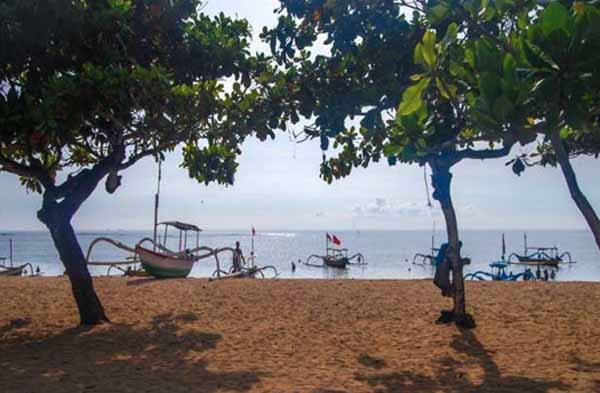
With its relaxed vibe, Sanur is an idyllic location. Situated on the southeast side of the island and only 30 minutes away from Denpasar Airport, its beaches are protected by an outer reef, providing a calm lagoon for ocean swims and activities.
One of the best things about life in Sanur is the three mile scenic paved walkway, which stretches from Mertasari Beach in the south, to Sanur Beach in the north, allowing for long walks or leisurely bike rides, plus the most amazing sunrise. There are many restaurants and warungs along the beach and in the main street, making it a foodie’s delight.
Differing from other expat hotspots, Sanur has managed to retain its traditional Balinese ambiance, despite being one of Bali’s earliest resort areas. It’s common to see women walking to the temples to perform their daily rituals with towering offerings on their heads, the brightly colored fishing boats rest on the sand and you’ll often find fisherman returning to shore with their daily catch.
Sanur’s restaurant scene has established itself over the past few years, so no matter where you’re situated or whatever your food or budget preference, Sanur has it.
Sanur isn’t well-known for its nightlife scene, but for late-night music you can visit the Linga Longa Bar, where a resident band plays from 8 p.m. till late. Casablanca showcases a different band each evening, with a Beatles cover band on Sunday night, which always proves popular. Arena Pub & Restaurant now features live music also and is a great place to meet other expats.
Lovina
For a relaxed Oceanside lifestyle, Lovina is the place to go. With amazing ocean views from most locations, it’s far enough away from the hustle and bustle.
Lovina is a good three-hour drive from Kuta and is four miles away from the energetic town of Singaraja, Bali’s second largest city. It’s known for its black sand beaches, coral reefs, and pods of dolphins. The town spans just over a mile east to west, with a small area in the Kalibukbuk village as its main focal point. Close to the sand, a dolphin statue stands as an official landmark. The calm waters provide enough opportunity for swimming, snorkeling, and diving.
There are many open-air bars, Western and Balinese-style restaurants, and you will find food and drinks are cheaper than the southern end of Bali.
The Global Village Kafe located on the main road, Jalan Raya Seririt-Singaraja, is a great place to not only grab food but to also help the local community. All their profits are donated to their charity organization, the Global Village Foundation. Enjoy ayam koloke, a sweet and sour chicken dish for $2.70 or a spaghetti carbonara for $3.50, followed with banana and Nutella crepes for $2.50. Or make your way to Warung Apple, a well-known little place close to the center of town. Here you’ll find a nasi campur, a plate of Balinese delicacies for $2 and the mixed seafood grill for $3 sounds just as good.
Uluwatu
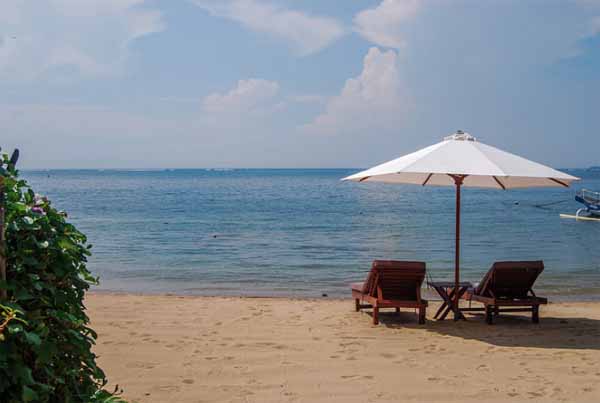
The southern tip of Bali island is known as the Bukit Peninsula. Ulu means “top” or “the tip”, and watu means “stone” or “a rock” in Balinese. Uluwatu is a popular area and best known for its landmark clifftop temple.
The region is picturesque, with the hilly limestone cliffs home to many five-star resorts, hidden beaches, and classic surf breaks. It’s said that this village was discovered by die-hard surfers in the 70s who made a small documentary called Morning of the Earth at the time. Besides the surf, Uluwatu is known for its amazing clifftop views and stunning sunsets.
Getting to Uluwatu is reasonably straightforward. From the airport, it’s about a 40-minute drive. The Mandara Toll Road makes all areas on this part of the island easily accessible. Irrespective of this, the area has not been swamped with tourists and has some beautiful, not-too-crowded beaches to explore.
Besides the many beaches and the temple, Uluwatu is not known for much else. But it’s a great place to discover, with many off-the-beaten path locations. Some of the beaches can be difficult to reach, with steep stairs, caves to shimmy through, and cliffs to squeeze past. But rest assured, once you reach the sand, the natural beauty surrounding you will be worth it. Dreamland Beach, Balangan, Padang Padang, Nyang Nyang, Uluwatu, Pandawa, Green Ball, and Jimbaran are a mixture of beaches providing something for everyone.
Uluwatu Temple (Pura Uluwatu) is one of Bali’s nine key directional temples. Even more remarkable than the temple itself is its location, perched on a steep cliff 230 feet above the roaring Indian Ocean waves. The temple is also home to some cheeky monkeys and fabulous views.
Canggu
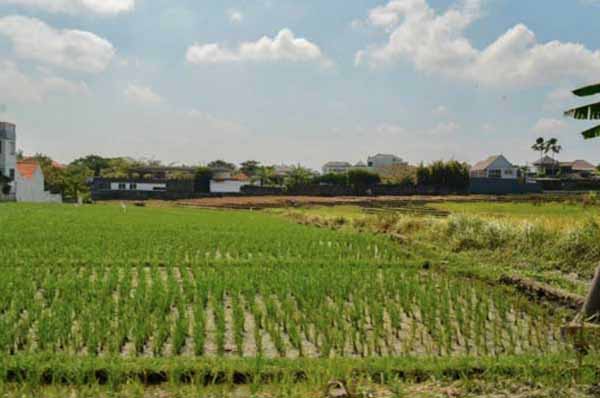
Arriving into the region of Canggu evokes a country feel. The traffic thins, the crazed pace of the southern tourist areas are left behind and there is a definite change to the urban sprawl. Fields of rice, banana plantations, and old-style warungs line the roadsides.
The towns of Legian and Seminyak have lured expats over the years, but only 15-minutes north is Canggu. A town that is unlike Ubud with its new-age feels or the laid-back town of Sanur, which has been a favorite for retirees for many years. Canggu just seems to have a different edge.
Canggu, pronounced “changoo”, is a village 12 miles away from Sanur. Encompassing quite a few beaches along the way—Batu Bolong beach, Nelayan Beach, Echo beach, Berawa beach, Selasih Beach, Seseh Beach, and Mengening beach. Away from the sand, it is still very much a rural area. The coastline is dotted with lava stone temples, some of them centuries old and important to the Balinese culture. Smells of frangipani trees and burning incense waft in over the sound of the crashing waves.
Over the past few years, Canggu has seen a transformation. What was once a series of small villages, spread along the three main beaches, have now become lively pockets of shops, restaurants, cool cafés and bars, spas, and some gorgeous villas. There’s a real buzz to the community, and it seems its popularity is increasing, with many considering Canggu the new “hot” location in Bali.
Candidasa
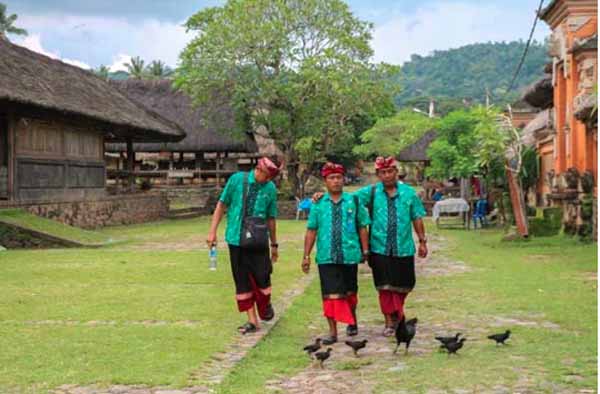
Candidasa is a popular seaside town located about an hour’s drive north of Sanur. The main road, which can be quite busy, runs parallel to the shoreline and is populated with places to stay, restaurants, cafés, and some stores.
It’s a great spot to explore some of Bali’s historical sites and has some famous dive spots nearby. The district of the Karangasem Regency contains volcanoes, rice fields, sweeping bays, and crashing waves. Tradition is still strong in the area, with many saying you can still find the “real Bali” here.
Candidasa is a laidback town. It is said it was first established as a fishing town in the 12th century, and before its modern name was known as Teluk Kehen (Bay of Fire) and Cilidasa. There is a temple, which still stands near the lotus-filled lagoon, featuring a statue of the fertility goddess Hariti, and many Balinese who want to have children travel here in the hope of being blessed.
Candidasa offers great diving sites, with three areas just off the coast. Gili Tepekong, Gili Mimpang and, to the north, Gili Biaha are three small islands seen from the shoreline of town. The currents can be strong, so it’s best to go diving with a reputable company. An hour away is the shipwreck USAT Liberty, where you can view oceanic sunfish when in season.
Visit Jasri Beach, where the giant swing allows you to release your inner child, and the chocolate factory allows for temptations. Take a local jukung, a Balinese boat, for a trip around the waters of the shore—the area offers fantastic views of Mount Agung on a clear day.
Most of your supermarket shopping can be done in Candi Basa, but no big names are here. You can buy most of what you need, but a trip to nearby Sanur or Ubud may be needed for anything special. There are local markets for fresh fish, fruit, and vegetables.
Candidasa may be a small town, but it sure delivers the relaxed lifestyle vibe. It’s a small expat community, but you are never far from the larger, more populated areas of Bali.
Ubud
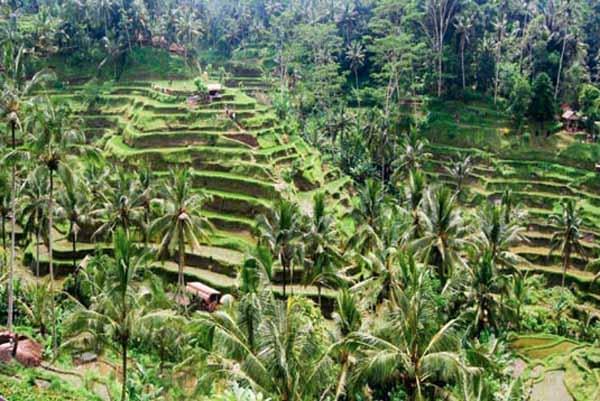
Growth continues quickly in Ubud, but you’ll still see the terraced rice fields along the rivers. And away from the town center, regular, quiet village life carries on relatively undisturbed. The local people still place offerings on the side of the road, and everyday you’ll see them riding to and from ceremonies, dressed beautifully in traditional clothing while holding their colorful woven baskets.
Colorful plants filled with flowers, large banyan trees, temples, brightly colored decorations, rice paddies, and sleepy villages still abound in and around Ubud. Spend some time there and you can feel the quiet and tranquility, where days become weeks and you’ll wonder what took you so long. And the strong expat community is testimony to this.
Ubud has a known history which dates back to the eighth century, when a Javanese priest visited Bali and meditated where the two rivers meet at Campuan. At the time, the town became well known for its natural healing and medicine, and that is how its name originated. Ubud in ancient Balinese means “medicine”. Over the next 400 years, temples and monasteries were established, many still standing today.
With the more natural lifestyle comes healthy eating, and Ubud has its fair share of great organic cafés, too. But it is just as easy to uncover life’s little indulgences as well. Tofu and chia breakfast bowls are just as easily found as your lychee and lemongrass mojitos, and delicious tacos. With hundreds of cafés and restaurants to choose from, you won’t miss out on anything. Yes, there’s a reflective focus on health, but that doesn’t mean the loud, live music bars, and decadent choices are hard to find. There is plenty of that too. Life is well balanced here.
In the early days, there was uncertainty as to the future of Ubud. However, a steady flow of visitors has since ensured the town’s evolvement. So many people have been captured by its intense landscapes and the gracious hospitality of the people. Ubud has managed to embrace the 21st century, and still retain its dignity, culture, religion, and timeless artistry, making it a popular choice for expats.
Bedugul

Bedugul is located around 30 miles from the southern tourist strip of Bali. The area enjoys a milder climate due to the location and the altitude. Cool air and soft mists are normal for the region, and most people love the area for its comfortable living. There are three crater lakes, Lake Bratan, Lake Buyan, and Lake Tamblingan, and close by the Bali Botanic Garden, which opened in 1959 and is the largest of its kind in Indonesia.
The lakes and the gardens are a favorite place to visit for the Balinese, Indonesian, and international tourists alike. Lake Bratan is the second largest lake in Bali, after Lake Batur, and is a major water source for irrigation in central Bali. The Beratan Temple is an important Shaivite temple in Bali and is located on the shores of the lake. Unfortunately, the lake waters are quite cool and not suitable for swimming.
Travelling from the busiest areas in the south to Bedugul, you realize the vastness of Bali, and the many areas which remain entrenched in traditions and culture. There isn’t a large expat community in the area, but they are there.
There are local supermarkets, but the major stores can be accessed from Ubud or Singaraja, which is a 20-minute drive away. However, the local markets are some of the best for fresh produce on the island. Behind the markets, you’ll find some local landscapers selling beautiful plants and some of the most amazing orchids. Strawberries are grown in the Bedugul area. A half-kilo pack will set you back around $1.80.

